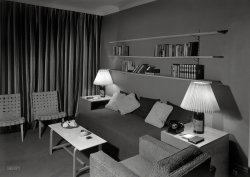
MAY CONTAIN NUTS

Search Shorpy
SHORPY ART

Framed or unframed, desk size to sofa size, printed by us in Arizona and Alabama since 2007. Explore now.
Join and Share
Ad-Free Shorpy
Shorpy is funded by you. Patreon contributors get an ad-free experience.
Learn more.

Recent comments
- Details, Details
- What's that building to the left of the tower?
- Coal Barges
- Bromo-Seltzer
- Inner harbor
- The Basin
- What a headache!
- Giant stepladder?
- Baldwin 62303
- Baldwin VO-1000
- Cold
- No expense spared
- Tough Guys
- Lost in Toyland
- And without gloves
- If I were a blindfolded time traveler
- Smoke Consumer Also Cooks
- Oh that stove!
- Possibly still there?
- What?!?
- $100 Reward
- Freeze Frame
- Texas Flyer wanted
- Just a Year Too Soon
- WWII -- Replacing men with women at the railroad crossing.
- Yes, Icing
- You kids drive me nuts!
- NOT An Easy Job
- I wonder
- Just add window boxes
Member Photos
The Shorpy
Print Emporium
Print Emporium
Search Shorpy
Search results -- 30 results per page
- This Time: 1948
- ... after the expected three years instead of delaying until 1955, this fine marque may well have survived for many more years.
Hudson ... from the early 1930s until the Jefferson plant closed in 1955. He was a diesetter and thus was responsible in part for shaping the ... Posted by Dave - 03/16/2015 - 7:04pm -
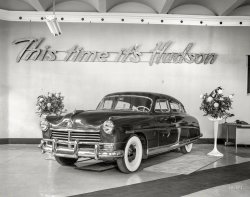
- Dead Man's Curve: 1920
- ... 100.
There was an article about it in the May 30, 1955 issue of Life.
Dead Man's Curve from the north and south:
... Posted by Dave - 08/26/2011 - 3:13pm -
![Dead Man's Curve: 1920 1920. "Dead Man's Curve. Baltimore tour." View full size. National Photo Company Collection glass negative. Note the tiny DANGER sign in the middle.
Location?Does anybody know where this is located in Baltimore? I'd love to get even a rough idea of where this is. I'd happily go back and take a modern-era photo of this.
Dave in Baltimore
www.seinberg.net
Product PlacementAt least after your car rolls off the road you know just where to get new tires and auto supplies.
Garrett Dash Nelson
Baltimore tourDid "Baltimore tour" have any special meaning, or is it just a tour around (?) Baltimore, or a ring-road perhaps?
[From what I can tell, it was National Photo's annual trip from Washington to cover the races at Pimlico. - Dave]
Dead Man's CurveUnderneath that "Danger" sign, it should say "If you can read this, it's probably too late."
Dead Man's CurveBecause of the billboards, this road is likely the old Route 1, the Washington-Baltimore highway. I lived on that highway in Beltsville in the 1940s and travelled it many times with my grandfather. I imagine that it would have looked like this in the days of this photo.
Dead Man's CurveIt's definitely Route 1 and seems to have been so well known back in the day that nobody bothered to say exactly where it was. I've been trying to localize it for over a year now. Current working hypothesis: it was on the upgrade approaching Elkridge from the south.
Dangerous CurveThis is part of the old Baltimore-Washington Road. This part of the road was relocated again to the west of the original alignments. You can enter this part of the old road from the east side of current Route 1 across from Ducketts Lane. The entrance is also about a mile north of State Route 100.
There was an article about it in the May 30, 1955 issue of Life.
Dead Man's Curve from the north and south:
(The Gallery, Baltimore, Natl Photo, On the Road)](https://www.shorpy.com/files/images/02559u.thumbnail.jpg)
- Grace's Garage: 1927
- ... in Silver Spring.
She had lived in Chevy Chase since 1955.
Mrs. McCathran, a Washington native, was a 1930 graduate of Central ... Posted by Dave - 08/31/2012 - 8:19pm -
![Grace's Garage: 1927 February 9, 1927. Washington, D.C. "Miss Grace Wagner, Central High School," out from under the car. National Photo Company Collection. View full size.
Grace WagnerThis is Joe Manning. I found this 2002 obituary for Grace.
Grace Wagner McCathran, 89, a Washington elementary school teacher from the 1930s to 1947, died of pneumonia Jan. 28 at Clifton Woods Group Home in Silver Spring.
She had lived in Chevy Chase since 1955.
Mrs. McCathran, a Washington native, was a 1930 graduate of Central High School. She was a graduate of Wilson Teachers College and received a master's degree in education from George Washington University.
She had taught first, second and fifth grades at the Alexander R. Shepard Elementary School in Washington.
Mrs. McCathran had been a member of the Chevy Chase Women's Club and the Brookdale Citizens' Association.
She was a member of All Saint's Episcopal Church in Chevy Chase.
Her husband, R.R. McCathran, whom she married in 1947, died in 1995.
Model TUnmistakably a 'Tin Lizzie', and the student parking lot was probably full of more of them to practice on.
[There was no "student parking lot" at Central High. This is 1927. - Dave]
This CarIs a Model T Ford. I hope Grace had as much fun in her life as it looked like she was going to have from her expressions in these pics.
Model T?Are you sure it's a Model T? Those were (I think) all 4 cylinders, and it looks like there are 6 exhaust ports visible.
That is a 4 cylinder.The Model T was not a crossflow design. It has two ports for the intake because the intake ports were siamesed. There are 4 exhaust ports.
From the rear of the engine, it's exhaust port, intake port, exhaust port, exhaust port, intake port, exhaust port.
Note the planetary transmission.
You may recall that the flathead V8 only appeared to have three exhaust ports per side because the center cylinder exhaust ports were siamesed.
I Thought The Same Thing......About this being a 6 cylinder engine at first. All the parts looked so big compared to the young slip of a girl working on it. But it did look like a planetary transmission of some kind which would have been right at home behind a Model T engine. You can also see some other similar details in the Model T engine photo on this Wiki page.
http://en.wikipedia.org/wiki/Ford_Model_T_engine
And if you're a true gearhead here's a link that shows how "babbit" bearings were poured in a Model T block and connecting rods.
http://www.nwo-modelt.org/blocks.html
Model T FordThis is absolutely a Model T. The radiator shell identifies it as 1917-1923. The absence of a generator mount makes it 1917-1918. In the foreground is the Model T transmission cover with its distinctive brake, reverse, and high-low pedals. The wrench Grace is holding is Ford Part #2335, for spark plugs and head bolts.
(The Gallery, Cars, Trucks, Buses, D.C., Education, Schools, Natl Photo)](https://www.shorpy.com/files/images/16489u.thumbnail.jpg)
- Keiths New Theatre: 1907
- ... the late 1920s/early 30s as vaudeville faded. She died in 1955.
Sadie My Creole Lady Sheet music from 1902 - words and music by ... Posted by Dave - 07/30/2012 - 10:08pm -
![Keiths New Theatre: 1907 Philadelphia circa 1907. "Entrance to Keith's Theatre." When was the last time you patronized your local vaudeville house? 8x10 glass negative. View full size.
Megaphone and BellAll the tools needed for your modern bus driver. That and muscles like Popeye to steer the darn thing.
Grand EntranceThis is such a beautiful entrance! It's over the top, but I LOVE it. I hope its still around. We have lost so many beautiful buildings and have either a parking garage or a Plain Jane block building with no architectural interest.
[Demolished in 1971. More here. - Dave]
StrippedIf you look at the photo in the article that Dave lined to, you wouldn't know that it was the same building. By 1968 (when "Ice Station Zebra" - the movie that was showing in the picture - was released) the building had all of the features of the magnificent French Renaissance style facade stripped off or hidden behind the sort of "modern" glass and steel that was popular at the time.
We've all seen too many great old buildings ruined by owners and developers who were "improving" the appearance of their building, said improvements falling out of fashion as rapidly as they came into style. I hate to say it but tearing down this building was more of a mercy killing than anything else. What made it special had died long before.
RKO Radio PicturesGimme a K as in Keith's.
Amazing detail and spiffy derby hats too! This photo has so much wonderful detail - you don't know where to look first. I can't believe this was over 100 years ago! I bet the inside of the theatre is just as gorgeous as the outside!
Where was itDoes anyone know what address this was? It's extraordinary!
[1116 Chestnut Street, according to the page linked to in the "Grand Entrance" comment below. - Dave]
Gertrude Hoffmanwas an exotic dancer who toured on the Keith-Albee vaudeville circuit for a number of years. Her name at the top of the bill in this pic probably caused more than a little curiosity since some of her dances apparently flirted with — and at least one Kansas City judge declared, overstepped — limits of moral decency. She was married to composer Max Hoffman who, incidentally, was musical director of the Ziegfeld Follies of 1907. Gertrude dropped out of the public eye by the late 1920s/early 30s as vaudeville faded. She died in 1955.
Sadie My Creole LadySheet music from 1902 - words and music by Max Hoffmann and sung by Miss Gertrude Hoffmann.
LocomobileThe car is a four-cylinder 1905 Locomobile Model E Touring with side-entrance tonneau. This was the year that Locomobile discontinued all of its rear-entrance tonneaus in favor of "double side-entrance" bodies.
(The Gallery, Cars, Trucks, Buses, DPC, Philadelphia)](https://www.shorpy.com/files/images/4a18173a.thumbnail.jpg)
- The Great Race: 1915
- ... in 1902. They formed the United States Automobile Club in 1955 and turned over all sanctioning to them after the Le Mans tragedy caused ... Posted by Dave - 07/12/2012 - 10:44am -
![The Great Race: 1915 May 1915. "York, Pa., auto races -- start of Washington, D.C., cars." Please ignore the mold. National Photo Company Collection glass negative. View full size.
First or NothingThe American spirit - I love it!
Who won?Anybody? The guy with the bicycle?
Beefy No. 13Fat tires, heavy suspension, and trimmed down to fighting weight. (no lights for these racers, they pack just the essentials!) One can only imagine the engine under that loooong hood. And, by the license plate, it's street legal! It looks like these boys have done this before!
Watch out, boys!Right after crossing into Maryland on I-83, look out for radar traps. And then 695, the Baltimore beltway, has construction zone cameras for you speeders.
But seriously, most likely they took York Road through Towson, then maybe Charles Street into downtown Baltimore where they grabbed U.S. Route 1 somewhere south of town en route to D.C.
[They're in D.C., about to leave for Pennsylvania. - Dave]
Oh, drat. Yes, of course. OK then, new GPS info for everyone! "When possible, make a U-turn."
#6They're going to have to pedal hard to keep up.
I wonder...how many hats made it across the finish line.
Did AAA sponsor this race?The car behind race car #3 doesn't look like a race car and doesn't have the white thing across the hood with the car # on it. It does have what appears to be the AAA logo on the radiator.
No PedalsThe car on the far left is an Argo made in Jackson, Michigan between 1914 and 1918 that has been stripped of most of its body work and accessories. This one is from 1914 - 1916 as the later models were more conventional and cost more than $400. A Ford Model T Runabout cost about $345 in 1916.
The Argo had a 4 cylinder 12 horsepower engine, shaft drive, weighed 750 pounds, with a 44 inch tread width, 4 gallon gas tank, an expected 35 - 45 mpg, could go up to 40 mph, and two forward speeds and one reverse gear. It came equipped with tools, but if you wanted your top, windshield, generator, and headlights attached you had to pay $20 extra.
An extract from a LOC photo of an Argo and a close-up of the logo is shown below. The Argo was previously seen on Shorpy here, https://www.shorpy.com/node/11292, and here, https://www.shorpy.com/node/4332, and several other posts.
American Automobile AssociationThe car in the background with the AAA badge carries the officials of the race. The AAA became the official sanctioning body for auto racing in the US in 1902. They formed the United States Automobile Club in 1955 and turned over all sanctioning to them after the Le Mans tragedy caused them to rethink their goals. All racing during this period, including the Indy 500, was officiated by the AAA.
This is the same body that banned women from racing shortly after Joan Newton Cuneo won the amateur national championship.
Lexington Not Made Near ConcordThe car on the far right appears to be a 1910 - 1913 Lexington automobile which were originally made in Lexington, Kentucky and then Connorsville, Indiana from 1909 to 1927. A little more than 38,000 Lexington cars were built during that time.
Lexington won the Pike's Peak hillclimb in both 1920 (first and second places) and 1924 (first, second, and third places). An amazing performance for a tiny company.
Pictures of Lexington's are not easy to come by. The radiator emblem on this car is similar to the Lexington emblem in the color plate section of Jack Martell's book Antique Automotive Collectibles.
A picture of the a Lexington car that was in the Glidden Tour is shown below along with another picture. Note the radiator with the same shape (but no emblem on the radiator, just the company name in script).
The Streets and Sanitation truck behind the Lexington is also interesting with paper piled up inside, bags hanging off the back, and a mustachioed driver looking directly at the photographer.
At least one Lexington survives.
A day at the racesThese cars are not racing the ninety-miles to York—they are traveling there to participate in the July 5, 1915 series of five-mile races on the York half-mile dirt track. Nearly all of the contestants were from the Washington D. C. area, and had been expressly invited by the York Motor Club, under whose auspices the meet was held. While BradL is correct in his assessment of the AAA, this particular event was not sanctioned by them. In fact, the event was being held for the Washington drivers who had been suspended by the AAA on June 18 for driving in another non-sanctioned race at the York track on the previous Memorial Day. Irvin Barber and Don Moore—along with their cars—were "disqualified and suspended" for one year, and six other drivers who were not AAA members were placed on the ineligible list for a similar length of time. Although they were not named on the list of ineligible non-members, Walter Smith and Milo Burbage didn't join the AAA until the first available date after the ban was lifted on June 1, 1916. At the time Smith was still recovering from a self-inflicted gunshot wound received in February, 1916 in a suicide attempt.
This photo shows eight of the twelve cars that were going to race at York. It was taken on Saturday July 3, 1915 shortly before noon, and is a bit of a homecoming for Shorpy readers, as a few of these people have graced these pages in the past. They are gathered by I. T. Donohue's auto parts store at 14th and I Streets in Washington D. C.—that's Franklin Park to their left—ready to start out at 12 o'clock sharp for a (non-competitive) 90-mile run to York where, as planned, they arrived in time to participate in the 8:00 p.m. automotive parade.
Irvin Donohue was quite the race booster and in his store he had on display the Batavla tires and Rayfield carburetor that had been on Irving Barber's car May 31 at York, when he took first place in a 5-mile free-for-all, and second place in a handicap free-for-all (after skidding off the track, spinning completely around twice, and driving back onto the track). Donohue, himself a racer and an AAA member, went along this trip and served as pit crew for the drivers.
The cars and drivers, as near as I can identify them, are (front row-left to right):
The red and white 1915 Argo Speedster with Walter L. Smith (middle initial is not "F" as the news photo has it), the 22-year old owner of the Smith Motor Sales Company, at the wheel. Next to him is, I believe, his father Ulysses Grant Smith who was born in 1865 (naturally), and served as the private secretary to the Secretary of Commerce.
Next car over is Irvin C. Barber in his bright red 90-hp Carter Brothers-built 1914 Eye-See-Bee (ICB) Washington-based race car (and below is a shot of it in racing trim two months later at the Benning race track in Maryland, just outside of Washington):
When the car was first built in the spring 1914, it was shipped to Indianapolis to participate in the Memorial Day 500-mile race as the "Washington Special" (with Batavia tires furnished by Donohoe). Backed by a wealthy New York broker, the car was to be driven by Mel Stringer, with Barber as relief driver. Although they could hit 90 mph on the straightaways, their 77.680 mph qualification lap wasn't good enough to land them a spot in the starting lineup.
On November 27, 1916 Miss Eleanor Blevins (also known as Peggy and by her married name Betts) used the Eye-See-Bee to break the Philadelphia-to-Washington speed record. With Bailey Gish as her riding mechanic, she made the dash in 3 hours and 15 minutes actual running time (exclusive of all necessary stops)—shaving 35 minutes off of the old mark.
The car in the middle is the circa 1914 Semmes Special with Raphael "Ray" Semmes at the wheel, but Lew Gibson, the man to his left, was the driver at the event (below is same car at speed two months later at the Benning track):
The second car from the right is a circa 1914 Case owned by Don Moore, although G.E. Feeney (in the seat to Moore's left) drove the Case at York, while Moore drove a Mercer owned by Milo Burbage.
The car on the far right is a circa 1912 Stoddard-Dayton driven by William DeKowski.
Back row-left to right:
This appears to be the circa 1913 Cole that was driven by C. Cleveland "Cleve" Campbell.
The car in the middle of the back row is a circa 1911 Warren-Detroit, raced by H. B. Sharp. It was an older car, and had been Barber's before he had the Eye-See-Bee built.
The last car on the right is Paul Miner's 1914 Buick. He too was a member of the AAA (hence the badge), but hadn't raced in May.
The drivers/cars that were at the race but not shown in the picture were: Harry D. Myers/Marquette Buick; Milo C. Burbage/Mercer; and Robert M. Clendening/Oakland; and Frank Stewart/Reo.
On Sunday most of the drivers prepped their cars for Monday's race. This would entail the removal of some or all unnecessary appendages and body parts—if they hadn't already been removed before they left Washington. This could result in quite the menagerie of styles as seen in the photo below of the Labor Day races at the Benning track two months later. The #2 Chevrolet Series H Royal Mail roadster nearest the camera retains it full body minus headlights, while the next two cars (#18 and #15) are stripped to the bare bones. The #17 car is a full bodied speedster with headlights mounted, while the #12 Ford on the far side has a custom body for racing.
Walter L. Smith's Argo Speedster was already stripped down, so Smith took the opportunity of the off day to drive a sixty-mile round-trip to Lancaster and back. On Monday he arrived at the track ready for the light car event, but when no other cars in his class showed up, that match was scrubbed. Undaunted, Smith promptly entered the diminutive Argo in a five-mile scratch race for cars up to 301 cubic inch displacement—putting it against the Mercer, Semmes Special, Cole, and the Buicks. The Mercer won in 7:06 with Don Moore at the wheel while, astonishingly, the Argo beat out two other cars—coming in at 7:58 for a fourth-place finish. The five-mile scratch race for cars from 301 to 450 cubic inch displacement was won by Barber in his Eye-See-Bee at 6:35. The five-mile free-for-all was won by Barber/Eye-See-Bee at 6:24, and the five-mile Australian pursuit race was won at 6:24.5 by Moore/Mercer. An Australian pursuit race is where all the cars begin the race in motion and evenly spaced around the track. When the flag drops the race starts and as soon as you're passed by a car from behind, you are out of the race. Obviously, it goes until there is only one car left. In the case it was Milo Burbage's Mercer, driven by Don Moore.
More was expected of Harry Myers' Marquette-Buick which, with Ted Johnson driving on Nailor's Hill, held the hill-climbing record of Washington D. C., but it did not win any races at York. Myers owned Riggs Garage at 1467 P Street in Washington. The only downside to the day was Frank Stewart's crash at speed in his Reo. He walked away, but the car was totaled.
It wasn't that bad of a loss however, as the Reo was one of the oldest cars in the race and due for retirement. In a few years Frank Stewart would found the Standard Automotive Supply Co.
Most of this group kept racing, most notably at Benning's in Maryland, but the AAA doesn't appear to ever have suspended any of them again for driving in non-sanctioned contests. In fact, it seems to have dropped the penalties for the AAA members, as both Barber and Moore drove in the AAA sanctioned race at Benning's in September. Eight months after the York race Paul Miner went into business with George and Charles Rice and opened The New Garage at 1323 H St. NW, in Washington.
This business soon expanded to 1317-27 H St. NW as the Geo. C. Rice Co. Their address overlapped with the Hotel Hudson.
Cleve Campbell left for Europe the next year and worked for the American Volunteer Motor Ambulance Corps in France, then spent a year in London fitting artificial legs to wounded soldiers. Milo C. Burbage was a bricklayer from Ohio who made it big as a contractor in Washington. Today his house in on the Prince George's County (Maryland) Historic List.
(The Gallery, Cars, Trucks, Buses, D.C., Natl Photo)](https://www.shorpy.com/files/images/SHORPY_32181u.thumbnail.jpg)
- Swing Street: 1948
- ... out that new club, Shorpy.
Miss D and Bebop Back in 1955 I was blessed to have had a very pretty and hip eighth grade English ... Posted by Dave - 02/01/2019 - 1:08pm -
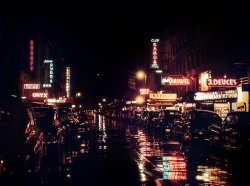
- Fill 'Er Up: 1942
- ... See Again It Saturday: My father's Gulf station c. 1955. I remember peering into the water-filled Coke cooler.
The pause that ... Posted by Dave - 05/29/2015 - 12:49am -
![Fill 'Er Up: 1942 June 1942. "Tracy, California. Tank truck delivering gasoline to a filling station." Photo by Russell Lee for the Office of War Information. View full size.
StreamlinedBack when even utility vehicles had style.
Missed my chanceThe Tracy Inn is still there. For several years I drove past Tracy on 580, never knew there was anything there to see.
Several identification clues hint...that this truck is a 1937-1942 White model 820.
Gas station memoriesSee Again It Saturday: My father's Gulf station c. 1955. I remember peering into the water-filled Coke cooler.
The pause that refreshesThe Coca-Cola box at far right looks like one that would have had bottles of Coke submerged in icy water so cold you thought your hand would freeze while you fished one out. But, oh, that taste on a hot day! And the curvature of the cold bottle was perfect for rolling across your forehead between swills.
At the gas stationThe car parked at the Associated gas station building is a 1941 Studebaker sedan, rather dowdy looking when compared to the very aerodynamic styling of the post-war Studebakers. When introduced to the public at dealerships in June, 1946, the 1947 models were truly futuristic in design and about equally loved (or despised.)
Coke ice boxLarc, my grandfather had a gas station in Callahan, Florida, with one of those Coke ice boxes and you are correct about how cold the bottles got. His had a sort of track that held the neck of the bottles and you slid the one you wanted to get it out. My favorite was Grapette. Sometimes I got to fill the thing with bottles and dump out all the bottlecaps.
As you may remember, there used to be promotions where a kid could get into a Saturday movie matinee for a couple of bottlecaps of a certain brand and a quarter, and I took full advantage of that at the movie theater in Fernandina, where we lived.
My grandfather must have had thousands of the attached postcard made of his station and the adjoining restaurant and motel, as they are always available on eBay. The site is now a CVS.
Correct me if I'm wrong...but weren't Flying A gas stations owned by Gene Autry? Never much of a singer or actor, but a damn smart businessman.
[OK. The "A" in Flying A gas stations came from the Associated Oil Company. No connection with Gene Autry's Flying A Ranch, Rodeo and later TV production company. -tterrace]
Now a parking lot...but the building next door still stands tall.
Long, long ago, in a galaxy far, far away,before the invention of the octagon for stop signs, there were "Comfort Stations." Some of them were Certifiably Clean. Clean enough for a baby.
[Note that there is an octagon, however. -tterrace]
Grape drink in ice-cold vending machine. Yum!All this talk of icy cold Coke... I guess my favorite was Grape Fanta in a coke machine that was full of ice-cold water with the track holding the bottle like the ones mentioned above.
I loved the old-fashioned gas stations with full service bays, tires, and wash racks. I miss those times, and thank Shorpy for bringing back the memories.
Octagon?Sorry, tterrace, but the star in your example on JDC-OKC's comment is 7-pointed so it must be a heptagon.
[Not the star, the octagon. -tterrace]
(The Gallery, Cars, Trucks, Buses, Gas Stations, Russell Lee)](https://www.shorpy.com/files/images/SHORPY-8c32173a1.thumbnail.jpg)
- Cafeteria Cuisine: 1943
- ... Going steady with a senior?
No Fine Dining From 1955 to sometime in the early 60's I remember paying a quarter for a school ... Posted by Dave - 08/08/2014 - 9:57am -
![Cafeteria Cuisine: 1943 May 1943. "Keysville, Virginia. Randolph Henry High School cafeteria. Typical lunch for 15 cents: candied yams, macaroni and cheese, fruit salad, deviled eggs, dessert and milk. Milk is free and children can have as much as they want." Photo by Philip Bonn for the Office of War Information. View full size.
Two Bits for a Barber....Looks like she paid for her lunch with a Barber quarter. Traded a shave and a haircut for lunch and some change. Of course, it might be a Barber half, kinda hard to tell.
[It's a half; compare to the size of the Liberty Walking half on the dollar bill in the tray and that to the Standing Liberty quarter (flying eagle up) in the left slot. -tterrace]
SilverThe dimes, quarters, and half-dollars are all silver, and that dollar bill is probably a silver certificate.
$0.15 = $2.07The inflation calculator calls $0.15 in 1943 $2.07 today.
Where's the BeefEntirely too healthy for my taste. In my day the school fed us nice greasy sloppy joes every day. Or at least it seemed like every day.
The RingGoing steady with a senior?
No Fine DiningFrom 1955 to sometime in the early 60's I remember paying a quarter for a school lunch. Milk was 2 or 3 cents, maybe it was only if you wanted an extra one, I don't remember. But here's the caveat - most of the food was really, really, lousy. The occasional chocolate milk, ice cream, chili and cinnamon rolls were the the only things we liked. You couldn't get an ice cream unless you ate ALL the rest of the slop they put on your tray. The ballon armed cafeteria ladies would cook and steam the daylights out of any flavor left in the government surplus commodity meat and veggies on the menu. Every Friday was limp fish sticks to appease the Catholics. Wow, I was always thankful when my mom would make me a meal to take to school in my Zorro lunchbox.
Today's Currency...I wonder what would happen today if I walked into a fast food restaurant and handed the high school age order taker a 50 cent piece. Would they even know what it was. It has been a long time since I have seen one.
Phonograph Records?The rack full of phonograph records seen in the upper left hand corner seems out of place in such a setting--did they have music while they dined? Perhaps the cafeteria doubles as a place for sock hops and dances at other times, like the later "cafetoriums"?
Missing meatIt went to the boys in uniform.
I'm younger, but --Things didn't change much by by the 60's. I remember paying for lunch ahead of time and getting tickets that were turned in to the school secretary who doubled as cashier. Meals were a quarter, milk was a nickel by that time. If I saw the menu for the week in time and saw something I didn't like, my mom would fix my lunch. This routine pretty much lasted through high school except for the cost increases. Some of the food was pretty gruesome, but I've never tasted anything to compare with the peanut butter/honey/corn syrup sandwiches and Alabama biscuits we got. You'd think you had died and gone to Heaven when you ate that. The spaghetti was good too.
The records in the photo are probably a mixture of classical music, square dance music, audio for some slide projector or filmstrip lessons. Remember those? Teacher's Pet got to turn the knob on the projector when the commentator on the record said to or there was a beep. The cafeterias in our schools doubled (and still do in the elementaries) as gyms and event centers.
No meatAnother incredible photo that is worth more than a thousand words! I'll bet they rarely got meat for school lunch, in 1943. Meat was heavily rationed. The items shown here are some of those that Americans had access to, during the war. We didn't go hungry, but did have to become more creative. Jello was used extensively. I think that's fruit in the jello in that lettuce leaf, but there are other possibilities. My dad remembers having to eat green jello with nothing but cabbage in it, that his aunt would bring home from her job at a college cafeteria. The makers of Jello even suggested putting leftover bits of vegetables and meats from Sunday dinner into a Jello mold, made with one of their vegetable flavors, for Monday!
Americans were actually very fortunate to have the food we did! The shortages and rationing that our allies had to live with was much, much more restrictive, and went on not only during the war, but for several years after it, too!
Cafeteria FoodMy Junior High and High School had excellent lunches, "real" food and plenty of healthy choices even if you just wanted a sandwich, you could get a P & B. Maybe it was the cooks we had? By the time my kids were in Jr & High School the food was slop just like today. Darn I packed a lot of lunches.
CoinsMy eyes immediately went to the Flying Eagle and Walking liberty. Some nice silver there!
(The Gallery, Eateries & Bars, Education, Schools, Philip Bonn)](https://www.shorpy.com/files/images/SHORPY-8d31365u.thumbnail.jpg)
- Golden Rocket: 1957
- ... in cars now. The four-door hardtop, introduced by GM in 1955, took quite a bit of engineering. The roofs, however, tended to collapse ... Posted by Dave - 09/10/2015 - 10:40am -
![Golden Rocket: 1957 Columbus, Georgia. "Oldsmobile dealer." The Golden Rocket 88 Holiday Sedan for 1957. 4x5 inch acetate negative from the News Archive. View full size.
Shoe optionTwo-tone to match the paint? Yes please!
Roof lightingYou might think there's a used car lot up there, but it's actually the spaceport.
Fast CarMy parents had a 1957 Olds Super 88. My cousin and I were riding in the back seat with my dad driving. We looked up to see what my dad was up to and saw that we were going over 110 mph. As I remember, I think that slowed him down. I don't believe Missouri had a fixed speed limit in 1957. The good old days.
All bricked up...when they built the viaduct over the rail yard, I would guess. Close inspection of the building through the vegetation on the right matched the 1957 photo. Last used as a Mitsubishi dealer.
"8" SpeechA phonetic "phooey":
A Deal You Can't RefuseC'mon down, folks. If you buy this little number today, I'll include this futuristic space-age antenna.
Rusting ALREADY?Is it my imagination or is there already rust on the back door? I see a spot with streaks below it just ahead of the rear wheel!
[Pontiac had its Silver Streak; Olds had the Brown Streak. - Dave]
13th and 5thThis is the northeast corner of 13th street and 5th Avenue in Columbus. The construction of the 13th street bridge took its toll on this deco building. I believe it became Rustin Oldsmobile around 1962.
The upper level was for extra parking (still is) and for showing new models as well. I remember driving by there for years and seeing shiny new cars perched on the edge of the abyss.
[Who can tell us the name of the dealership in 1957? - Dave]
Rucker OldsmobileIn 1956, it was Rucker Oldsmobile Inc., 1300 5th Ave., TEL 3-7313, according to Polk's City Guide for Columbus (Muscogee County) Georgia and Phenix City (Russell County) Alabama. With apologies to the Rustin family, the 1962 name change to Rustin Oldsmobile was an unexpected gift for local punsters and other comedians.
Consumer ReportsConsumer Reports bought a 1957 base-model Golden Rocket 88 in 1957 and remarked that with the exception of the Chrysler 300, it was the most powerful car they had ever tested--not surprising when you consider how recently these brands had been virtual puddle jumpers.
In prior years, both the Super 88 and 98 had the same higher compression engine with a four-barrel carburetor with a lower compression two-barrel in the base 88. However, in '57 in an attempt to gain back some of the performance lost to the very powerful Pontiac and Chrysler 300, all Oldsmobile series were equipped with the same 371 cubic inch four-barrel setup but with different axle ratios--3.07 for the base model, 3.23 for the Super 88 and 3.42 for the 98. The only engine option was the three two-barrel J-2 setup available for about $75 in any model.
BumperThe front bumper makes it look like it had collagen injections for the "bee-stung" look.
Hardtop StylingBack when there was enough steel in a four-door car to toss out the B-pillar and roll down those windows for some real open air driving. Sigh. I had a 1965 Imperial LeBaron a few years ago that had no B-pillar. That small, missing detail really made rolling down the windows a liberating event.
[There's generally more steel in cars now. The four-door hardtop, introduced by GM in 1955, took quite a bit of engineering. The roofs, however, tended to collapse in rollovers. - Dave]
ObscureThanks, Dave, it has taken me two days to find that pesky "phonetic phooey"! That's the fun of Shorpy, finding noted details. I can rest easy tonight!
98 RocketHad a girl friend in high school whose mom had 1957 98 four door sedan with the J2 option. When asked why, she replied, "Because it's fast!"
(The Gallery, Cars, Trucks, Buses, Columbus, Ga., News Photo Archive)](https://www.shorpy.com/files/images/SHORPY-657.thumbnail.jpg)
- Pontiac Purveyors: 1936
- ... 20 years and became more or less a Pontiac trademark thru' 1955 or '56, second only the the Indian Chief.
Third Car Interlopers ... Posted by Dave - 12/17/2014 - 9:03pm -
![Pontiac Purveyors: 1936 "1936 Pontiacs and salesmen at the Mark Hopkins Hotel, San Francisco." Lined up at the Bottom of the Mark. 8x10 inch Kodak safety negative. View full size.
Third Car is a 1935 ModelThe third car with the headlights attached to fenders and different insignia is a 1935 model. Could this photo have been taken in late 1935 when the 1936 models were introduced?
Fender sittingDon't try that on your new car today, you'll wind up with dents.
Car number 3Is a '35. Guessing that #4 is your base model with no straight 8 engine or emblem, and painted as opposed to chrome grille.
Some are new, some are notVitojo, the two that have the headlights mounted to the fenders are 1935 models; the rest are '36 models. Notice also that on the '35 models, the side elements of the grilles contain vertical bars, instead of the horizontal bars seen on the '36 models.
Cool hood ornamentThat Pontiac hood ornament; the Indian w/the ring around it was very fragile --I wonder how many were intact a year later
Different PontiacsThe third car from the front is a 1935 Pontiac. It is very similar to the '36s. The '35 introduced the first "turret top". The most noticable difference was the front door hinge location, which was moved from the front to the back.
Re: Third car from the front or the backI think the car with the headlights not attached to the nose is a 1935 model while the others are 1936. Someone near my house had a 1936 Pontiac similar to these for sale last year. I would drive by and think how great it would be to own something like that, but boy you would have to know a lot about old cars (and where to get parts!) to maintain something like that.
What no tailfins?I was born just as cars were starting to sprout tailfins, but if asked to draw a car today, one representing all, this is the silhouette that comes most often to mind. A lasting design statement.
I love those grillesI do, I do, I do.
"The wheels will fall off", as Mom would sayMy father, a genius certified by the U.S. Army, loved Pontiacs, even more than the Cadillacs, Studebakers, and Jaguars he'd owned. Perhaps it was the adventure aspect--searching for mechanics in the most remote scenic byways of pre-interstate America. All of us kids remember vividly our made-up games of collecting bottlecaps to while away hours as Dad and the Sinclair greasemonkey reattached the wheelhub of our '56 Chieftan, our '59 Starfire, our '63 GTO or our '66 Bonneville so we could get on with our vacation. It was no wonder that whenever Dad came home grinning with the new one, Mom would say simply, "The wheels will fall off".
Heading home two weeks ago, the turn lane onto my street was blocked by a police cruiser. "An accident", I thought. But no, the officer was merely protectively blocking off traffic for a man in one of the last Pontiacs built, its right front wheel, hub and all, detached and lying over on its side nearby.
Dad finally admitted at age 80 that Mom was smarter.
Nevertheless, one of my fondest memories is as a child of three, driving my uncle's hot pink '56 Pontiac down the brick streets of Amarillo, Texas, with my mother and aunt in the back seat asking, "Do you think this is a good idea?" Thank goodness the wheel didn't fall off.
Pontiac StripesThose long stainless stripes that sweep down over the front of the hood decorated Pontiacs in one form or another, every year for 20 years and became more or less a Pontiac trademark thru' 1955 or '56, second only the the Indian Chief.
Third Car InterlopersThe two Pontiacs with the headlights not attached to the nose are 1935 models. The other Pontiacs, with the lights attached just behind the grille, are from 1936. The 1935 models were the first with the "Silver Streak" running down the hood.
The two cars in the background are 1935 Fords.
Third car from the front or the backHeadlamps not attached to the nose and different insignia. What would be the difference between these and the others? Very stylish cars indeed.
The Silver Streak PontiacsThe two Pontiacs with headlights attached to the fenders instead of the nose are 1935 model year cars. Also note that the third from the back has turn signals on the fenders, this was called the "Improved" model and it also featured a more artistic hood ornament. The hood ornament on the third from the front is the normal 1935 version.
[I believe those are parking lights, not turn signals. -tterrace]
Silver StreakThis was the second year for the brand identifying metal band down the hood and on the trunks of some models and would stay around through 1956.
FascinatingNearly 20 years later my grandfather, father and two uncles would strike exactly the same pose outside of the family business with their company Buicks (Dad's was a cherry red convertible).
(The Gallery, Cars, Trucks, Buses, San Francisco)](https://www.shorpy.com/files/images/SHORPY-168-01.thumbnail.jpg)
- Happy Family: 1954
- ... Emmy winner would be coming soon to the big screen in the 1955 noir classic Kiss Me Deadly . 35mm negative from photos by Phillip ... was startled at how beautiful she was in the show. Even in 1955, her talent showed.
Ida Looking much friendlier here than as the ... Posted by Dave - 06/08/2016 - 1:15pm -
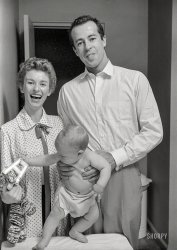
- Real [Blank] Spaghetti: 1940
- ... soup with Velveeta cheese and bologna. This was circa 1955 in Lexington. Kentucky was and is nice (I went to U of Ky), but ... Posted by Dave - 11/20/2011 - 6:30am -
![Real [Blank] Spaghetti: 1940 November 1940. "Greek restaurant in Paris, Kentucky." Mussolini's Fascist regime has just invaded Greece, and the word ITALIAN has been painted over. 35mm negative by John Vachon for the Farm Security Administration. View full size.
You might think all spaghetti was ItalianBut my ex mother-in-law made spaghetti sauce using Campbell's tomato soup with Velveeta cheese and bologna. This was circa 1955 in Lexington. Kentucky was and is nice (I went to U of Ky), but Connecticut is better for Italian food.
First we stop at Nick'sfor a plate of unknown spaghetti, then next door to pick up a new Chevy.
Real Spaghetti SandwichesYum! I bet those are good sandwiches. After lunch I think will go and buy a Hevrolet.
Axis powerWhy would they black out "Italian." Perhaps it has something to do with the run-up to WWII.
[Perhaps it was WWII itself, and the caption explains it. - Dave]
Childhood RhymeWhistle while you work,
Hitler is a jerk,
Mussolini
Is a meanie,
Whistle while you work.
As for the "real spaghetti sandwiches," we actually had a kid in our class who brought those from home for lunch as most families had little meat. Also sardine sandwiches, plain mayonnaise sandwiches, etc. I kind of like going back to the 40's since even after 70+ years I still remember those friends and conversations. I have read that your childhood friendships were the real thing because little kids have not developed the phoniness, social obligations, artificiality or opportunism persona, but accept each other at face value. I miss my old friends, but I digress, I'll shut up now.
LSMFT in the '40s"Lucky Strike Means Fine Tobacco." It also could mean "Lord Save Me From Truman." Heard it both ways many times in the late '40s and early '50s.
No Italian spoken hereMy stepsister, who was Icelandic, spoke Italian. We lived in the U.S. from 1941 to 1944, when she was 7-9 years old, but she refused to utter a word in that language. I only spoke Icelandic and Danish, so I didn't have that problem.
I wish I still had my Hitler button. It had a string that brought Der Führer up with a noose around his neck when you pulled it. It was an interesting time for us kids, totally oblivious of the horrors of war, although we saw saw some action in October of 1941, when the convoy we were a part of was attacked by German subs. We didn't get hit, but we saw the Reuben James get it. Woody Guthrie wrote a song about that historic sinking.
Eating for successI know it is not the intent of the sign, however, I have had spaghetti sandwiches even recently. Best eaten on an Italian roll with smashed meat balls, a good sauce and sprinkled cheese. During the Depression, my mother took baked bean sandwiches to school. Other kids made fun, so she told them she loved baked beans so much that she asked her mother to make her lunch with them. Somehow, even hungry, the kids made it through and obtained a fine education. Now the kids get free school lunches - complain about them, and get lower test scores than ever. There must be a moral to learn there somewhere.
Rue Principale, Paris (KY)Nick's is now Charles' Barber Shop, and the Chevy dealership is an antique mall.
View Larger Map
Couldn't resist!Love the juxtaposition of old and new!
Mayo clinicNothing wrong with eating cheaply, so long as you're eating. When my dad was a student at University of Florida in the 1950s, his budget allowed him to eat mostly mayonnaise sandwiches. He never complained that he despised it though -- he still loves mayonnaise to this day.
(The Gallery, John Vachon, WW2)](https://www.shorpy.com/files/images/SHORPY_8a32712a.thumbnail.jpg)
- School Zone: 1957
- ... taxicab and (yet again) 1953 Buick, supported by a trio of 1955 and '56 Ford police cars. 4x5 acetate negative from the News Archive. ... would be for a bank robbery?
Waiting in the wings A 1955 Rambler.
Crossing guard Thank you for pointing him out, Dave. This ... Posted by Dave - 08/10/2015 - 3:07pm -
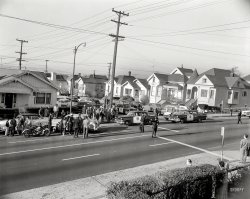
- Hopalong Christmas: 1950
- ... borde.
Fine, take the red one. Christmas of 1955 I was 6 and my brother was 4. Among many
treasures like these under the ... Posted by Dave - 07/29/2012 - 9:01pm -
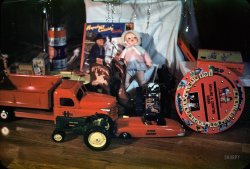
- Kitchen of Tomorrow: 1954
- ... me to a GM Motorama at San Francisco's Civic Auditorium in 1955 or 1956; I wish my memories were stronger, but what remains is of being in ... The cabinets remind me of the kitchen table we bought in 1955 when I came out of the Army. The same ugly Formica although we thought it ... Posted by Dave - 07/12/2018 - 8:04pm -
![Kitchen of Tomorrow: 1954 1954. "Harley Earl, General Motors Vice President of Design, in Frigidaire's 'Kitchen of Tomorrow' exhibit for the GM Motorama at the Waldorf-Astoria Hotel in New York." Large-format color transparency. View full size.
King FinBack in 1956, had I known he was the one responsible for tailfins on cars, I would have worshiped this man. My father took me to a GM Motorama at San Francisco's Civic Auditorium in 1955 or 1956; I wish my memories were stronger, but what remains is of being in a wonderland.
Back to the FutureIt's amazing how modern that kitchen looks, even today. Like something out of the Ikea catalogue.
Modern but flimsyEverything about that kitchen looks like it would fall apart with real use. Sure, it looks nice, but a few teenagers would destroy it in a month. And what's with the color swatches next to what looks like a microwave?
What's he doing there?Even before I read the caption, I thought, "That's Harley Earl - what's he doing in a kitchen?" Like Archfan, I see this being like a modern kitchen. On the left we see a water dispenser (though not incorporated into the refrigerator), a small color TV displaying a recipe, and a fully instrumented electric range. And I'm thinking that the brushed gray doors toward the right might be refrigerated cabinets.
[The "color TV" is some sort of microfilm recipe reader. You can see the "horizontal refrigerator" in action in this video. - Dave]
At the time, most of the automakers owned appliance makers. Besides GM's Frigidaire, there was Philco, owned by Ford, and Kelvinator, owned by American Motors. Chrysler's Airtemp made home air conditioning, and even International Harvester made refrigerators and freezers for awhile, targeting the farm families that bought their tractors and implements.
Kitchen Design?Looks more like his GM corporate office.
The ManA lot of people have been called "The Man". Harley Earl WAS The Man.
TimelessIt still looks modern today, in my view. And what an upgrade from just 30 years prior.
FormicaThe cabinets remind me of the kitchen table we bought in 1955 when I came out of the Army. The same ugly Formica although we thought it was quite nice at the time.
(The Gallery, Kodachromes, Kitchens etc., LOOK)](https://www.shorpy.com/files/images/SHORPY-1nnnnu1.thumbnail.jpg)
- Rest Stop: 1936
- ... I wonder if he got to go to Disneyland when it opened in 1955? He seems to already be a fan of Mickey.
Why did they have seven kids? ... Posted by Dave - 08/17/2012 - 10:01am -
![Rest Stop: 1936 July 1936. "Drought refugees from Bowman, North Dakota, in Montana." En route to Oregon or Washington. Medium-format nitrate negative by Arthur Rothstein for the Resettlement Administration. View full size.
Seven kids in one car!I agree with you OTY. The despair these people must have known in their lives. Seven mouths to feed and bodies to clothe. I can't imagine.
Is that a AAA Trip-Tik she's reading in the car? It sure looks like one.
"I'm Bored"Along with the words in my comment title, here are some of the things my four kids said on our cross-country auto trips 45+ years ago. "He's touching me." "There's nothing to do." "I'm thirsty." "I'm hungry." "I need to use the bathroom." "Mary keeps looking at me." "I'm too hot." "He's taking up the whole back seat." "Are we there yet?" That is just a small fraction of the crabbing, even though we had books, toys, little cars, games, crayons, snacks and cold drinks in an ice chest and we slept in motels at night. Here I see SEVEN kids, not a sign of a toy in sight, everyone looks exhausted, hungry and tired and their treat will be water rationed by Dad. We cannot even imagine the despair in the lives of these people but I bet there was not one single peep from anyone about their discontent, despite the lack of Gameboys, Hot Wheels, snack-paks, cold beverages, iPods, auto TVs, etc. What strong character they had, even the tiniest of the group, and we are so spoiled.
As if all this toil and trouble weren't enoughOne of the triplets has managed to bust himself an arm. Big sister, I am sure, is quite a help to Mother, who comforts the most recent addition to the family while checking a map. That rear tire could use some air but I'm guessing that's the least of Dad's worries right now. And whoever told him Montana's the place to go must not have seen this particular spot.
Hanging water bags up front in the airflow helped lower their contents from hot to tepid, some times. Often it was useful to knock the dead bugs off before you drank, so some of them didn't join the water going into your mouth.
The Canvas water bagworks on the principle of evaporation. The bag is slightly porous and the evaporation of the water that comes through the bag cools the water. It's out on the radiator to get lots of air. And I assume as a side benefit the cooler air passing around the bag may help cool the radiator.
My Dad had one. Being born in 1889 I imagine he used them on trips. I believe the bag is still around in the house or garage somewhere. I'll have to look for it.
Wade
Water bagTo those of a certain age (like me), a familiar sight was what's sometimes called a "desert water bag" hanging in front of the radiator on passing cars. Here's a rare shot of one in actual use. I'd always assumed the water was strictly for the radiator, not human consumption.
I'm Next!I drank from one of those until 1953. Nice cold water. We always carried it out west from Texas to California and back. It was the only thing that was cool on our '38 Pontiac in the summer.
I wonder if he got to go to Disneyland when it opened in 1955? He seems to already be a fan of Mickey.
Why did they have seven kids?Because there wasn't room for eight of them in the machine.
My grandfather was about this man's age and always referred to any automobile as "the machine." I think that was rather common terminology for his generation.
Brother!This shot just makes me puddle up!
Wow, a family of nine.Let us hope they did all right.
[Papa was evidently no idler. -Dave]
The 2-Door Sedan Picturedis a 1927 Chevrolet Coach. The Coach was one of eight body styles available that year. It had a 171 cubic inch, overhead valve 4-cylinder engine and a 3-speed transmission. Chevrolet made just over 1,000,000 vehicles in 1927 and outsold Ford for the first time.
Meryl Streep lookalikeThe oldest daughter looks like she was self-consciously reaching to take off her glasses before the photo was taken. (She also bears a striking resemblance to Meryl Streep.) She must have been miserable crammed in the back of that car with five younger siblings (assuming that the baby rode up front with Mama).
Shoes for girls, barefoot boysInteresting to note that here we have a clear example of where the kids being barefoot is not an issue of poverty as we might have otherwise assumed. Seeing several barefoot boys in a cramped car in the Depression era would suggest parents too poor to provide shoes. But the fact that all the girls, even those younger than some of the boys, wear shoes proves that the boys are barefoot out of choice. Or perhaps because it was more socially acceptable or even expected for boys to run around that way but not for girls.
(The Gallery, Arthur Rothstein, Great Depression, Kids)](https://www.shorpy.com/files/images/SHORPY_8b28059a.thumbnail.jpg)
- Steeling Home: 1941
- ... New Orleans Inevitably reminds me of Robert Frank's 1955 photo of a New Orleans trolley. In choice of subject and framing, Delano ... Posted by Dave - 04/04/2022 - 5:30pm -
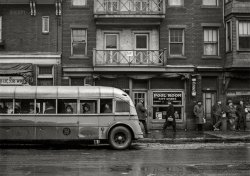
- Auto-Railer: 1935
- ... up on the Chicago, South Shore & South Bend RR in 1955, with a platform on the roof for working on the overhead wires in East ... Posted by Dave - 05/28/2014 - 7:29am -
![Auto-Railer: 1935 ANNAPOLIS, Md., June 26, 1935 (AP) -- Negotiations have been started by the Evans Products Co. of Detroit for the purchase of the Washington, Baltimore & Annapolis Railway, which was recently sold at auction here. The company manufactures buses and trucks that operate either on rails or on the highway, and it is understood the concern plans to operate 100 passenger and freight units between Washington, Baltimore and Annapolis. ... The "auto railer" consists of front and rear steel pilot railroad wheels attached to a conventional type of bus or truck. The pilot wheels are raised for operation over highways but can be let down when the vehicle reaches the tracks. The vehicle runs on its own tires over the rails with the pilot wheels guiding it along the track.
1935. Washington, D.C., or vicinity. "Streamline Bus and Car, Evans Motor." Harris & Ewing Collection glass negative. View full size.
Are any extant?If so, what a novel and attractive project for a guest house/lake/mountain house conversion.
Let me beYou can stand there all day and have your picture taken, for all I care, but this headlight is really something interesting.
SafetyPresumably you can retract the wheels and drive off the tracks when a real train comes along too.
Washington and Old DominionThe Washington and Old Dominion obtained one of the Evan units from the defunct Arlington and Fairfax and converted it to a maintenance vehicle.
Kickin' the TiresSir, I advise you NOT to kick THAT tire.
Evans Auto-railer in actionI recalled seeing an old clip of this machine in action, and here it is. I believe that the scenes were taken along the Grand Trunk Western Jackson Subdivision which ran from Pontiac to Jackson, MI. The branch was abandoned in 1975.
1935 fashionBroad lapels, rolled up trousers, hats and no belly fat!
[Those are real cuffs. -tterrace]
Not a Bump in a CarloadFairmont Railway Motors (now Harsco Rail) is often given credit for coming up with the road-rail technology that created "hi-railers" (they spell it "HY-RAIL") in the 1940s, but the various versions of the Evans product had already been in production for years. The car-like one below was known as the M2.
Their largest Auto-Railer (below) was only one of over a dozen diverse products they made for the war effort during WWII.
Modern TravelerEveryone has done such a good job on the history of auto-railer that I am left to guess at the signage behind the gentlemen. TRIAL “Modern Traveler” ROAD RAIL COACH BODY? Love the Art Deco font.
[SUPERIOR "Modern Traveler." Also: CHEVROLET CHASSIS, TIMKEN AXLES / GOODRICH & UNITED STATES TIRES. The "Modern Traveler" was a streamlined bus body made by Superior Motor Coach Co. of Lima, Ohio. - Dave]
C-Span connectionEvans Products was founded by John Steptoe Evans, whose grandson John D. Evans was a co-founder of C-Span.
Evans Products started out building wood products; first, a wooden block that allowed easy loading of autos on railcars, then cedar separators for the plates in a car battery. John S. Evans set a record in 1928 by flying around the world in 28 days.
Gramps' good jobI knew my grandfather worked for a company called Evans so I emailed my dad this link. here was his reply:
"Yes, this is the same Evans Products. More than that, your grandpa spent a couple of his years at that time driving one of these for the Company when we lived in Detroit. He would be gone for weeks at a time. First, he worked in a small city, Paris, Illinois, and later was transferred to Washington, DC. It always sounded like a good idea to me. It was equipped with both railway wheels and rubber tires, with a mechanism to lower the rubber tires or raise the railway wheels, so they could use the seldom-used rail lines like street-car tracks. Of course the rail lines fought them and tried to scare the public about potential collisions. In the end, the politicians voted against it ... but your grandpa was part of it."
Alas, he's not in the photo, but what a pleasure to see a glimpse of his world. Thanks, Shorpy!
Gramps' JobThat Washington, D.C. job may have been on the Arlington & Fairfax trolley line, which replaced its electric cars with Evans Autorailers. I think they wanted to drive them across the Potomic River without using the D.C. streetcar tracks. One of those later wound up on the Chicago, South Shore & South Bend RR in 1955, with a platform on the roof for working on the overhead wires in East Chicago, Ind.
(The Gallery, Cars, Trucks, Buses, D.C., Harris + Ewing, Railroads)](https://www.shorpy.com/files/images/SHORPY-39036a.thumbnail.jpg)
- A Learning Experience: 1957
- ... Integrated The high school I attended was integrated in 1955, the year I was a freshman, and we never had any problems of any sort. I ... Dad, Calvin Frye, graduated from Anacostia High School in 1955. He grew up in DC.
(D.C., Education, Schools, News Photo Archive) ... Posted by Dave - 03/15/2020 - 3:13pm -
![A Learning Experience: 1957 September 10, 1957. "Integrated classroom at Anacostia High School, Washington, D.C." 35mm acetate negative by Warren K. Leffler for U.S. News & World Report. View full size.
Intergated?Where are they boys?
[In Remedial Spelling. - Dave]
IntegratedThe high school I attended was integrated in 1955, the year I was a freshman, and we never had any problems of any sort. I guess we didn't know we should have.
Based on available evidence and probabilitiesIt's a girls' health class and they're singing a girls' health song.
Vocalizing?They’re all either speaking or singing in unison.
They look older than their yearsThey're teenagers, but appear to me to have an average age of about 35. A couple could pass for grandmothers. I suppose it's due to their hairstyles, eyeglasses, and dresses.
The sad old daysI went to segregated elementary schools in the South as an Army brat, and then would go to integrated schools when we were stationed overseas. As a kid who paid no attention to politics, I just figured there were no black kids were in my schools in Georgia or North Carolina because no black families lived in my neighborhood, whereas, overseas, we had black families living in the same stairwell, so of course those kids went to the same school with me and were our friends.
Class of '55My Dad, Calvin Frye, graduated from Anacostia High School in 1955. He grew up in DC.
(D.C., Education, Schools, News Photo Archive)](https://www.shorpy.com/files/images/SHORPY-03095u.thumbnail.jpg)
- A Cowboy Named Sue: 1968
- ... horses Why yes sir, I had one of those horses as well. 1955 or so would be the date I was given mine. More than one or two injuries ... Posted by CheeseHead - 03/03/2012 - 7:42pm -
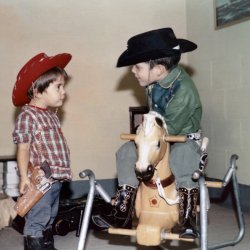
- Sachs Third Avenue: 1940
- ... Manhattan and southern Bronx portions of the El closed in 1955, in anticipation of the (sarcasm alert) coming real soon! (/sarcasm alert) ... El, which came down almost as soon as service ended in 1955, the Bronx section north of 149th Street wasn't demolished until several ... Posted by Dave - 07/22/2013 - 6:24am -
![Sachs Third Avenue: 1940 November 5, 1940. "Sachs Quality Furniture Inc., 150th Street & Third Avenue, New York. General exterior, daylight. Morris Lapidus, Ross-Frankel Inc., clients." Large-format acetate negative by Gottscho-Schleisner. View full size.
Sachs' Bronx BranchIn Manhattan, Third Avenue terminates at 128th Street to become the Third Avenue Bridge. This street corner is in the South Bronx. It's now occupied by a pawn shop.
No Area Code NeededMelrose 5-5300 was the telephone number that Sachs Quality Furniture used in its radio commercials. It was sung in a jingle that became instantly recognizable. Glen Miller's Pennsylvania 6-5000 it wasn't, but it did deliver the message efficiently. Please don't confuse Sachs Quality Furniture with Saks 5th Avenue, the upscale Department store or Saks 34th Street of "Miracle on 34th Street" fame.
Ahead of its timeEven though it was constructed in the late 1930s, the Sachs storefront has many of the elements that defined "googie" coffee-shop architecture of the mid to late 1950s, from the lazy roof edge curves and tall skinny columns to the vast expanses of glass and the "floating" inner roof of the showcase.
[This is actually classic Streamline Moderne. -tterrace]
MemoriesI just spoke to a 92-year-old friend of mine who grew up a few blocks away from this location in the Bronx and he immediately recalled Sachs' radio jingle with its phone number: MElrose 5-5300.
Another ghostly remnantVisible at the upper right corner is some of the track structure for the late lamented Third Avenue El. This would be just north of the 149th Street station, where a free transfer was available to the Third Avenue station of the White Plains Road/Dyer Avenue subway lines, today's 2 and 5 trains.
Although the Manhattan and southern Bronx portions of the El closed in 1955, in anticipation of the (sarcasm alert) coming real soon! (/sarcasm alert) Second Avenue Subway, the Bronx portion from 149th Street north to the Gun Hill Road terminal remained in operation for another 18 years. It used 1920's-era "Lo-V" cars until the late 1960's. For the last few years of the line's existence R-12 "Redbird" cars from 1948 operated on the line.
On April 28, 1973, revenue service finally ended on the Bronx portion of the Third Avenue El, although there was a "fantrip" for rail enthusiasts the following day. The R-12's went to Flushing 7 line, where they ran for about another decade before being scrapped. Unlike the Manhattan portion of the Third Avenue El, which came down almost as soon as service ended in 1955, the Bronx section north of 149th Street wasn't demolished until several months after the end of service. Some of the old line's steelwork is still visible at the Gun Hill Road elevated station on the 2 line.
Aware that the Bronx Third Avenue El's closing could be a financial burden for the residents of the mostly lower-income neighborhoods along the line, who normally would have to pay separate fares to ride buses to the nearest remaining subway stations, the Transit Authority created a new bus line following the El's route and offering free transfers to the subway. This arrangement lasted until 1996, when the MetroCard fare card allowed free subway-bus transfers systemwide.
Sach's jingleI too, remember the MElrose 5-5300, along with many other jingles of the time. I'm sure some will recall "National Shoes ring the bell, for all smart women who want to dress well." And, "Nedicks B1." For those of us who were youngsters in the early forties probably remember Tom Mix's song which started "Shredded Ralston for your breakfast" and ended with "Take a tip from Tom, go an tell your mom, Shredded Ralston can't be beat." Ah those memories . . .
(The Gallery, NYC, Stores & Markets)](https://www.shorpy.com/files/images/SHORPY_5a05929u.thumbnail.jpg)
- Corner Store: 1937
- ...
1899: Tode & Co.
1943: Service Food Market
1955-present: Isle of Capri Ristorante
Food is still sold there But it's ... train ran in front of Mr. Campanelli's store until 1955. Noise levels dropped and property values soared, perhaps explaining the ... Posted by z396z28 - 09/15/2012 - 1:31pm -
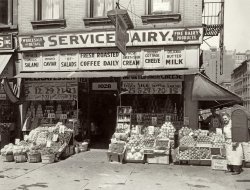
- Niagara Falls: 1958
- ... Likely a DeSoto 1957 (yellow)
13. Probably a Chevrolet 1955 (black)
The lady walking in the black dress along the wall behind the ... Posted by Islander800 - 11/24/2012 - 10:51pm -
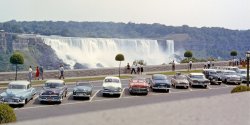
- Out on a Limb: 1954
- ... about a year and a half later, after the flood of December 1955. Lost some neat toys in that flood, like several 1940s-vintage Disney ... Posted by tterrace - 11/27/2017 - 1:27pm -
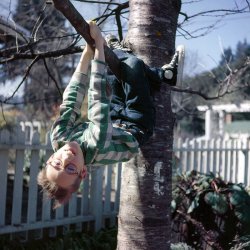
- Western Union: 1931
- ... were available (Second Avenue El 1940, Third Avenue El 1955, Jamaica Avenue El 1977), that actually wasn't the case with the Sixth ... Posted by Dave - 06/16/2013 - 8:39am -
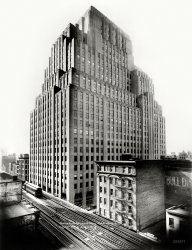
- Winter Sports: 1940
- ... who was a sentient being in America between 1935 and 1955 would recognize the children, the outfits, the houses, this street. This ... Posted by Dave - 12/27/2012 - 7:50pm -
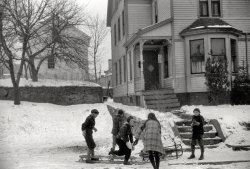
- Exchange Court: 1920
- ... jurisdictions horse traffic just faded out. I was born in 1955 and guys less than ten years older than me remember when my hometown ... Posted by Dave - 08/10/2012 - 3:47pm -
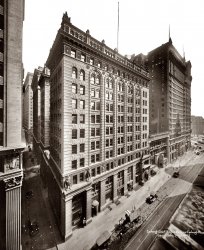
- Hank Aaron: 1934-2021
- September 8, 1955. "Hank Aaron standing in front of his locker with misspelled name in the ... Posted by Dave - 01/22/2021 - 1:43pm -
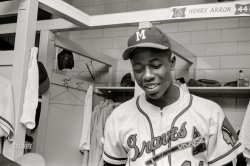
- Crunch Wagon: 1958
- ... that explains the aerial.
Rare new, Rarer now. The 1955 ford Ranch Wagon is rarely seen today. Very few people were interested in ... Posted by Dave - 01/24/2016 - 9:20pm -
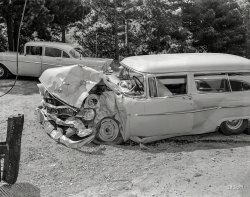
- Apartment D: 1949
- ... up for modern appetites. What had been our dinner plate in 1955 was a mere sandwich plate 50 years later. Bigger is not always better.
... Posted by Dave - 11/08/2013 - 12:36pm -
